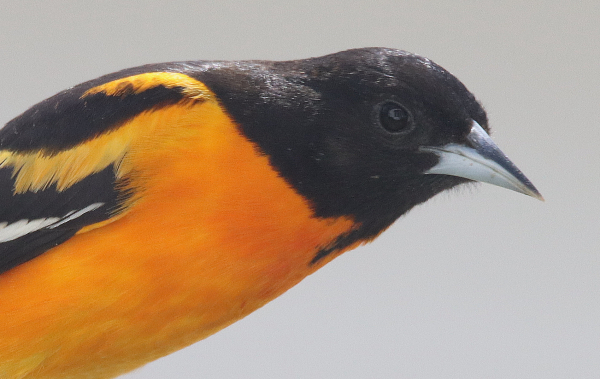
Baltimore Orioles are adding color and action to the view outside my bay windows as they are joined by at least 3 Orchard Orioles at my feeding station.
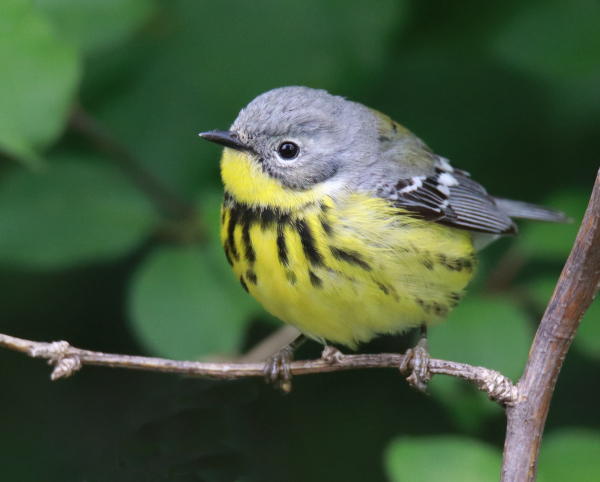
An adult female Magnolia Warbler provided the best photos of the species during a busy weekend of songbird sightings and photography.
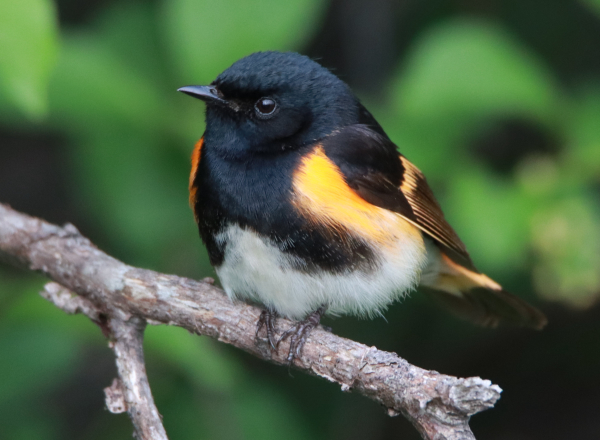
Male American Redstarts were especially active Friday at The Grove, along with an abundance of warblers and other songbirds. (Keep in mind how small these birds are when you see them in fine detail in these photographs.)
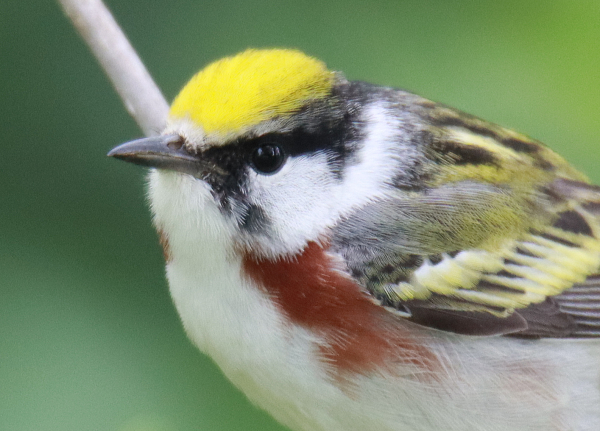
Different lone Chestnut-sided Warblers have continued to show up at Melody’s Grove this week after the first “Chestnut fallout” May 17th.
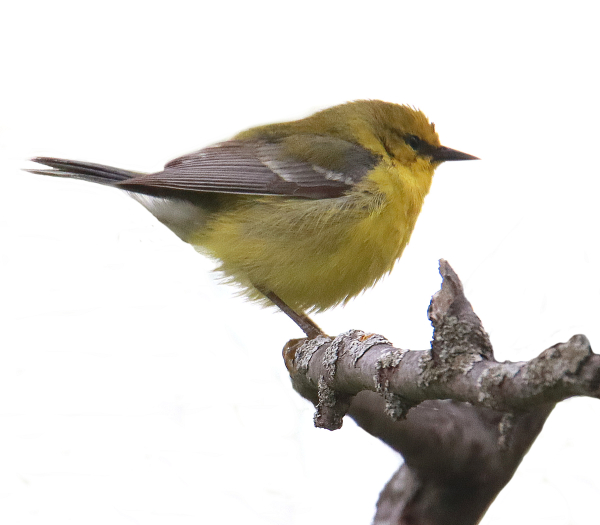
A personal “first of state” male Blue-winged Warbler was a big surprise Friday, observed and photographed shortly after returning from Portugal.
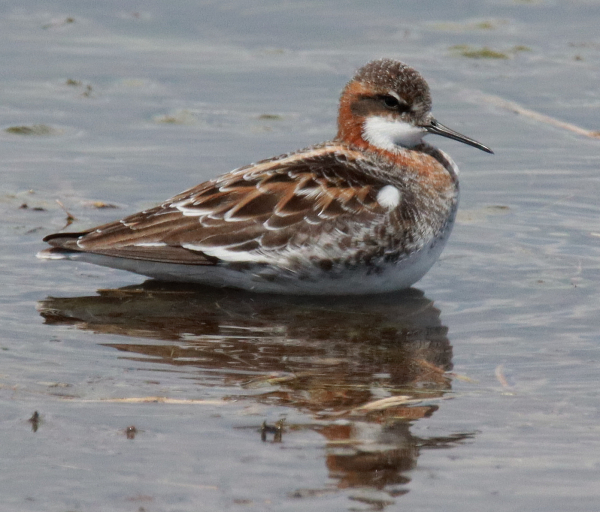
A very tired male Red-necked Phalarope was only the third individual of the species that I’ve observed in North Dakota, all at Charo Marsh, although the other Red-necks appeared during fall migration (female phalaropes are more colorful than males).
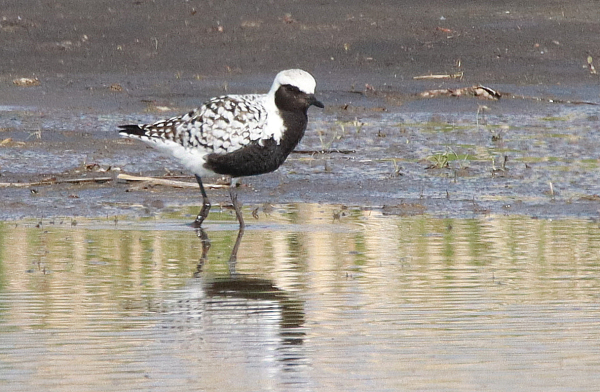
One of the flock of 7 Black-bellied Plovers that surprised me Sunday afternoon just 2 miles north of my office; I’ve only seen the species in the state twice before.
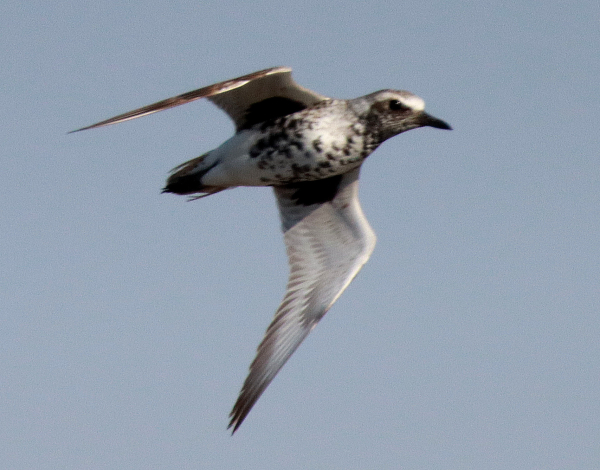
One of the molting Black-bellied Plovers flew nearby when disturbed by a small low-flying airplane. It is interesting to note that 5 days earlier I saw a similar flock of 8 Black-bellied Plovers during their migration stopover in northeast Portugal, where they are known as “Grey Plovers.”
|
After 5 days away from the warbler fallout of May 17th (the days I spent in northeast Portugal or en transit to and from Europe), would you believe I checked all my local birding hotspots before I went home? After being away 5 days, a lot of things could change, and they did, including finding a new species and documenting more “rare bird” sightings. My first stop was my warbler hotspot at Melody’s Grove and I was almost surprised that The Grove was very active, but especially glad to arrive in the midst of a songbird fallout last Friday, May 23rd (although BirdCast showed it was second biggest migration overnight this spring).
It was quickly evident that the dominant species working their way through the lower level of bushes and trees at the Grove were Tennessee Warblers and Yellow Warblers, with the same base species present Saturday to keep things lively. Mixed in were some especially spectacular birds, including a personal “first of state” male Blue-winged Warbler that I observed twice, plus a yearling Canada Warbler (a species that rarely stops here). There was a fine Connecticut Warbler, only the third I’ve seen here, several male American Redstarts, a few Magnolia Warblers, Wilson’s Warblers, and female Blackpoll Warblers, plus another fine Chestnut-sided Warbler.
There was also the first male Ruby-throated Hummingbird I’ve seen this May, along with the first Orchard Orioles, all males. Others included male Baltimore Orioles and Red-eyed Vireos, Warbling Vireos, Northern House Wrens, Gray Catbirds, and a new species for the Grove and the surrounding area – a pair of Eastern Bluebirds that appeared to be setting up a nesting territory – wouldn’t that be great. By Saturday evening it seemed like the songbirds moved on, and Sunday morning was very quiet in The Grove, but I did have 2 skulking warblers slip through the low cover just above ground – a female Common Yellowthroat and a male Mourning Warbler.
Monday morning, Memorial Day, The Grove looked rather bleak again, but as it turned out a young Magnolia Warbler suggested there was more to this morning than initially indicated, and it was followed by a brilliant male Magnolia. A male Mourning Warbler slipped into view near ground level, and I managed a couple photos of it on a low shadowed perch. A female Common Yellowthroat was next, and the treetops were enlivened by chases between male Yellow Warblers. A female American Redstart was also present, and after seeing these birds once, it was hard to say if I was seeing the same birds repeatedly, or if there were several of the same species and sex. A male Orchard Oriole was singing in the area, and it perched in the open toward the end of my holiday morning observations. That evening a few young Magnolia Warblers were active, as was yet another Chestnut-sided Warbler, a female American Redstart, and a number of Yellow Warblers. During morning and evening birding sessions at The Grove, a Swainson’s Thrush, a Gray Catbird, and several House Wrens and Least Flycatchers.
Shorebird Surprises!
After returning from Europe, Buff-breasted Sandpipers have been in my thoughts, and I mentally tried to conjure up a better photo chance with the rarely encountered shorebirds. During my first survey of the area in 6 days, I checked for shorebirds, with a pair of Stilt Sandpipers a standout among a flock of Semipalmated Sandpipers at Bobby’s Bay. Charo Marsh was the next shorebird hotspot on my route, and with more Semipalms and a Spotted Sandpiper on hand, another individual caught my eye with my first impression that it might be a Red-necked Phalarope.
Yes indeed, it was my 3rd Red-necked Phalarope sighting at Charo and in the state – a male in full alternate colors, ready for the Arctic nesting season. But now, the Red-neck was visibly tired, and mostly laid in the inch of cool water near the shore, closing its eyes often, standing occasionally, and giving me ample time to take a few documentary photos. More Semipalmated Sandpipers and a few larger White-rumped Sandpipers were on hand at the northwest side of Charo Marsh, and I continued to the main chokecherry grove on the southwest side of White Lake. There I found an abundance of male Yellow Warblers foraging with a few female Blackpoll Warblers mixed in, plus a male Orchard Oriole and a couple Clay-colored Sparrows.
Late Sunday afternoon I drove 2 miles north to Bobby’s Bay, where a pair of American Avocets and 4 White-faced Ibis were standouts with a couple dozen Semipalmated Sandpipers on hand. I decided to pull off the shoulder to try to photograph an ibis, and while in the process, I looked up to see some new arrivals at the far end of the bay – and I let out a muffled whoop! There were 7 Black-bellied Plovers standing on the edge of the water! Another unexpected flock of plovers making a quick stop to drink and move along. It was exciting to watch their activities before being startled by a small airplane that timed its low flight overhead for this exciting moment. But I had a chance to take a few photographs, including an image of one of the molting plovers in flight as it passed fairly close overhead.
Of course, the Black-bellied Plovers tie right in my recent sightings of American Golden Plovers, Hudsonian Godwits, Buff-breasted Sandpipers, and Ruddy Turnstones that I’ve only encountered between 1 and 3 times before during spring migration in Dakota. Similarly, I’ve only seen Black-bellied Plovers on a migration stop twice before! What a spring this has been for rare migration sightings! Three of the Black-bellied Plovers had already molted into breeding plumage, with the others in a variety of molt levels from almost totally molted to just beginning to molt.
All this was deja vu, considering that just 5 days earlier I had seen a flock of Grey Plovers in northeast Portugal, the first Grey Plovers of my life. However, Grey Plovers and Black-bellied Plovers are the same species; different by common name only. In the Eastern Hemisphere these birds are listed as Grey Plovers, but according to the pros at Cornell as described in Birds of the World, Grey Plovers are actually Black-bellied Plovers with a broad distribution, primarily in the Northern Hemisphere. Both flocks were making a migration stop, the “Greys” headed for the Arctic tundra of northernmost Russia, and the Black-bellies likely headed for far northern Canada – and I was able to see them en transit within the same week of time, wooo-wee!
A Black-tailed Godwit was also foraging in the company of the “Grey Plovers,” and that special sighting was significant because as I was leaving my Dakota home for the Fargo airport, I saw 2 Hudsonian Godwits and a Marbled Godwit feeding in the shallow water of Bobby’s Bay, about 2 miles north of home, which made see a total of 3 different godwit species in 4 days personally rewarding too.
It’s Oriole Time!
At home, I was excited to see if more orioles had arrived at my feeding station. Although I wasn’t in my house much Friday, I saw a female Baltimore Oriole visited the feeder late in the day, and Saturday I noticed 2 different females and at least 1 male during a brief time at home. By Sunday, 3 females and at least 3 male Baltimore Orioles were visiting my feeding station for grape jelly, along with at least 2 male Orchard Orioles and the first female Orchard of the year. As for Monday, just 1 Baltimore showed, a gaudy male. But after repeated feeding visits by 1 or more male Orchard Orioles, I caught sight of 2 male Orchards eating jelly at the same time, at different jelly feeders, plus a female Orchard fed separately a number of times.
Monday a White-breasted Nuthatch was the first to visit my feeding station since April, and a pair of American Goldfinches added some tiny bird activity outside my bay windows. Only 1 male Baltimore Oriole ate jelly Monday and Tuesday, but at least 1 female and 2 male Orchard Orioles were on hand. Tuesday a long-awaited Gray Catbird found my jelly feeders, joining others in the non-oriole crowd – American Robins and House Finches.
As we approach the last days of May, songbird migration may be moving toward a crescendo, as the best birds tend to appear toward the end of migration. So don’t let up, keep up your enthusiasm, and check on your favorite warbler locations one last time, or 2 or 3. That goes for shorebird hotspots and raptor territories too; plus local bird nesting habitats. Oh yes, I almost overlooked mentioning that the first duck brood of the season appeared Sunday – a brood of 8 ducklings feeding in the company of a female Northern Pintail, and a brood of 9 Mallard ducklings was present at Charo Marsh Monday afternoon. Enjoy the week ahead!
Article and Photos by Paul Konrad
Share your bird sightings and photographs at editorstbw2@gmail.com